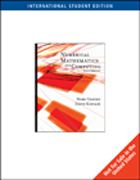
Authors Ward Cheney and David Kincaid show students of science and engineering the potential computers have for solving numerical problems and give them ample opportunities to hone their skills in programming and problem solving. Thetext also helps students learn about errors that inevitably accompany scientific computations and arms them with methods for detecting, predicting, and controlling these errors. A more theoretical text with a different menu of topicsis the authors' highly regarded NUMERICAL ANALYSIS: MATHEMATICS OF SCIENTIFICCOMPUTING, THIRD EDITION. INDICE: 1. INTRODUCTION. 1.1 Preliminary Remarks. 1.2 Review of Taylor Series. 2. FLOATING-POINT REPRESENTATION AND ERRORS. 2.1 Floating-Point Representation. 2.2 Loss of Significance. 3. LOCATING ROOTS OF EQUATIONS. 3.1 BisectionMethod. 3.2 Newtons Method. 3.3 Secant Method. 4. INTERPOLATION AND NUMERICALDIFFERENTIATION. 4.1 Polynomial Interpolation. 4.2 Errors in Polynomial Interpolation. 4.3 Estimating Derivatives and Richardson Extrapolation. 5. NUMERICAL INTEGRATION. 5.1 Lower and Upper Sums. 5.2 Trapezoid Rule. 5.3 Romberg Algorithm. 6. ADDITIONAL TOPICS ON NUMERICAL INTEGRATION. 6.1 Simpsons Rule and Adaptive Simpsons Rule. 6.2 Gaussian Quadrature Formulas. 7. SYSTEMS OF LINEAR EQUATIONS. 7.1 Naive Gaussian Elimination. 7.2 Gaussian Elimination with Scaled Partial Pivoting. 7.3 Tridiagonal and Banded Systems. 8. ADDITIONAL TOPICS CONCERNING SYSTEMS OF LINEAR EQUATIONS. 8.1 Matrix Factorizations. 8.2 Iterative Solutions of Linear Systems. 8.3 Eigenvalues and Eigenvectors. 8.4 Power Method. 9. APPROXIMATION BY SPLINE FUNCTIONS. 9.1 First-Degree and Second-Degree Splines. 9.2 Natural Cubic Splines. 9.3 B Splines: Interpolation and Approximation. 10. ORDINARY DIFFERENTIAL EQUATIONS. 10.1 Taylor Series Methods. 10.2 Runge-Kutta Methods. 10.3 Stability and Adaptive Runge-Kutta and Multistep Methods. 11. SYSTEMS OF ORDINARY DIFFERENTIAL EQUATIONS. 11.1 Methods for First-OrderSystems. 11.2 Higher-Order Equations and Systems. 11.3 Adams-Bashforth-Moulton Methods. 12. SMOOTHING OF DATA AND THE METHOD OF LEAST SQUARES. 12.1 Method of Least Squares. 12.2 Orthogonal Systems and Chebyshev Polynomials. 12.3 Other Examples of the Least-Squares Principle. 13. MONTE CARLO METHODS AND SIMULATION. 13.1 Random Numbers. 13.2 Estimation of Areas and Volumes by Monte Carlo Techniques. 13.3 Simulation. 14. BOUNDARY-VALUE PROBLEMS FOR ORDINARY DIFFERENTIAL EQUATIONS. 14.1 Shooting Method Shooting Method Algorithm. 14.2 A Discretization Method. 15. PARTIAL DIFFERENTIAL EQUATIONS. 15.1 Parabolic Problems. 15.2 Hyperbolic Problems. 15.3 Elliptic Problems. 16. MINIMIZATION OF FUNCTIONS. 16.1 One-Variable Case. 16.2 Multivariate Case. 17. LINEAR PROGRAMMING. 17.1Standard Forms and Duality. 17.2 Simplex Method. 17.3 Approximate Solution ofInconsistent Linear Systems. APPENDIX A. ADVICE ON GOOD PROGRAMMING PRACTICES. A.1 Programming Suggestions. APPENDIX B. REPRESENTATION OF NUMBERS IN DIFFERENT BASES. B.1 Representation of Numbers in Different Bases. APPENDIX C. ADDITIONAL DETAILS ON IEEE FLOATING-POINT ARITHMETIC. C.1 More on IEEE Standard Floating-Point Arithmetic. APPENDIX D. LINEAR ALGEBRA CONCEPTS AND NOTATION. D.1 Elementary Concepts. D.2 Abstract Vector Spaces. ANSWERS FOR SELECTED PROBLEMS. BIBLIOGRAPHY. INDEX.
- ISBN: 978-0-495-38472-4
- Editorial: Brooks-Cole
- Encuadernacion: Rústica
- Páginas: 763
- Fecha Publicación: 30/12/2008
- Nº Volúmenes: 1
- Idioma: Inglés
